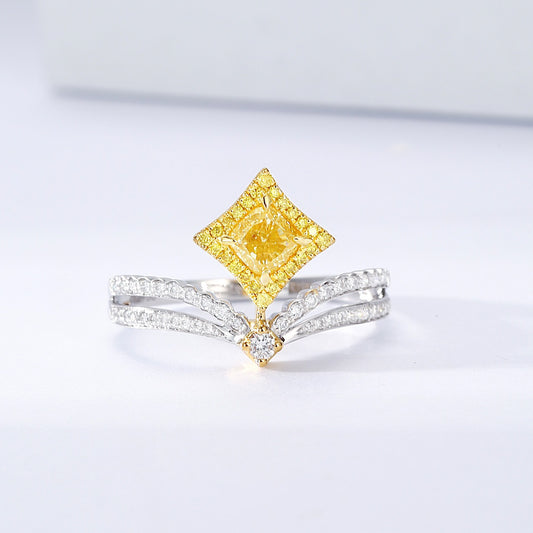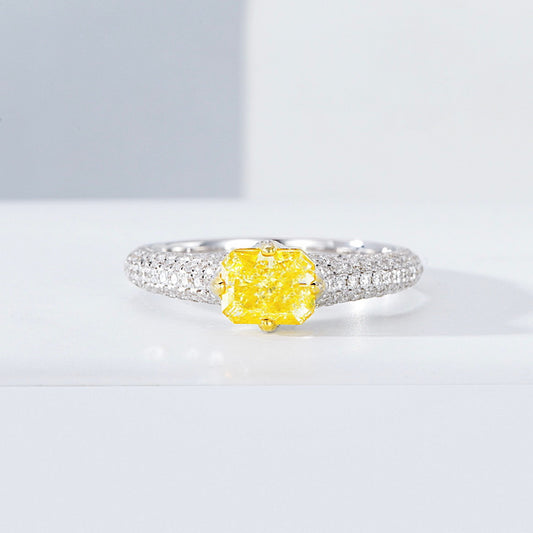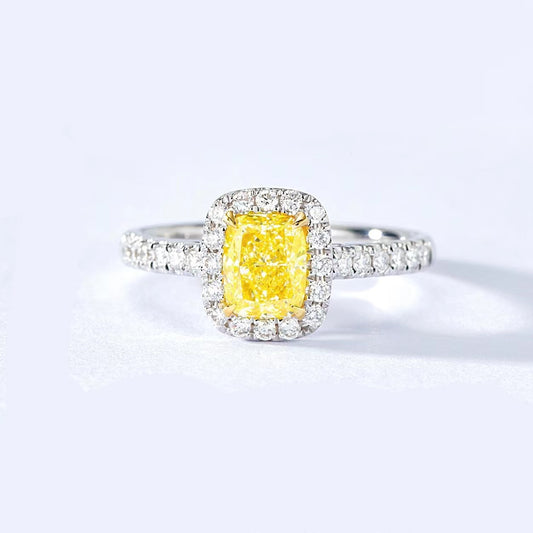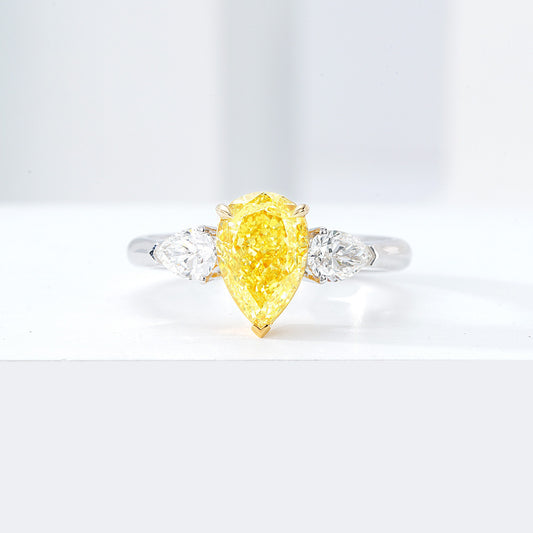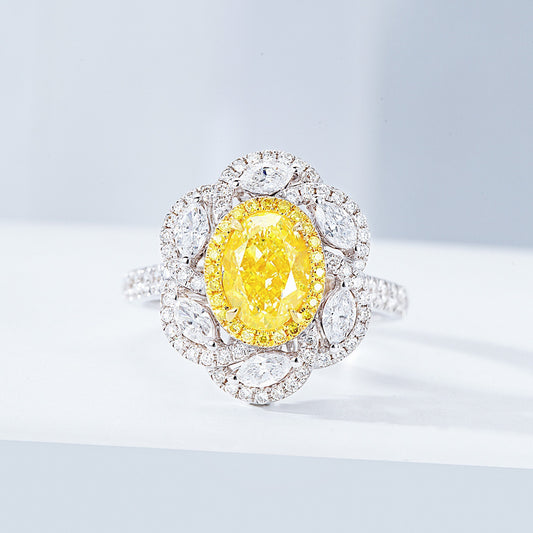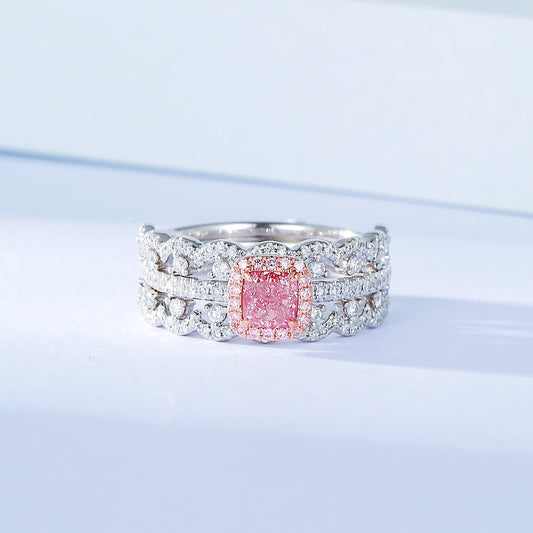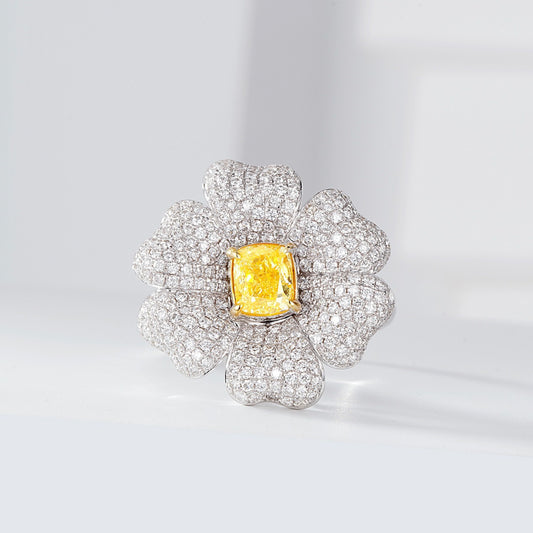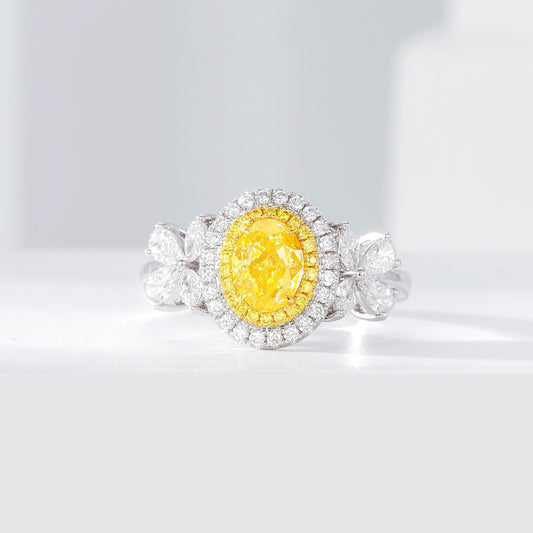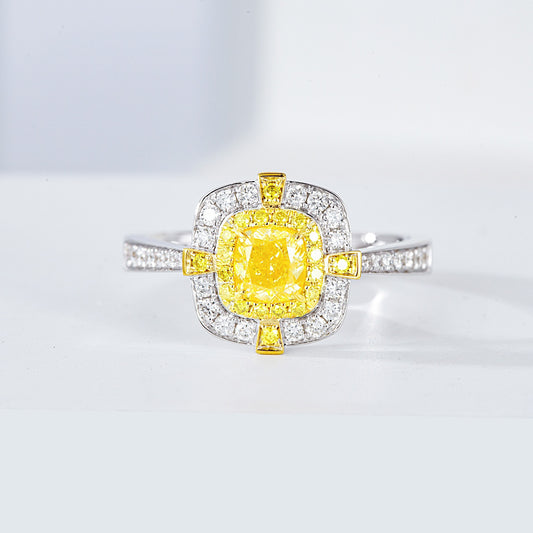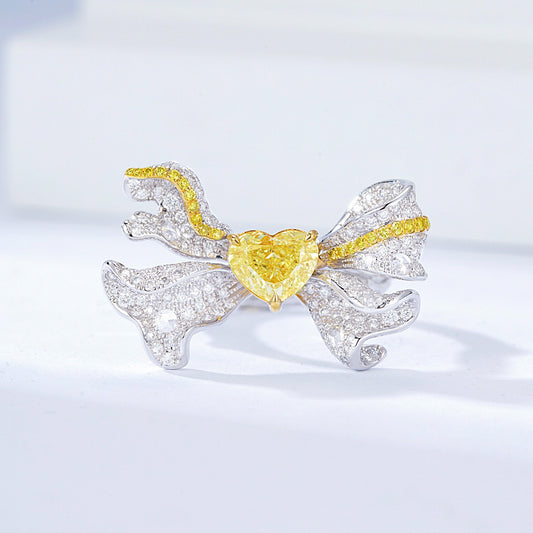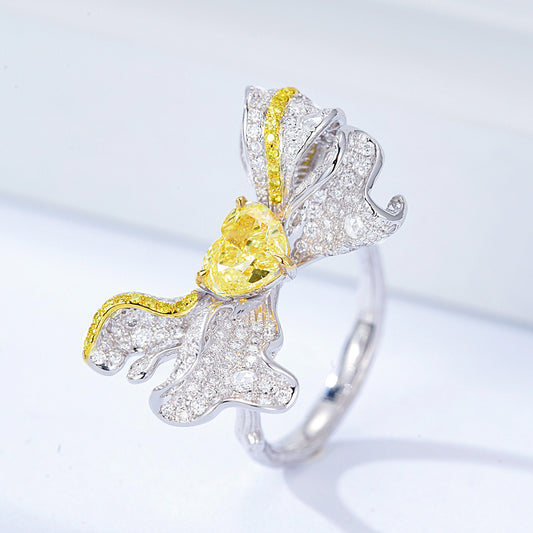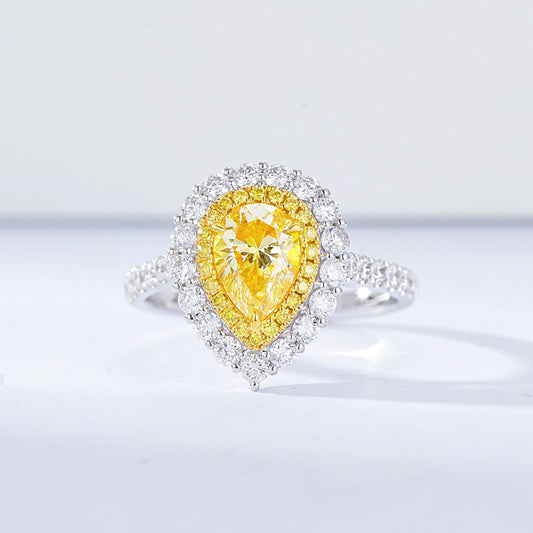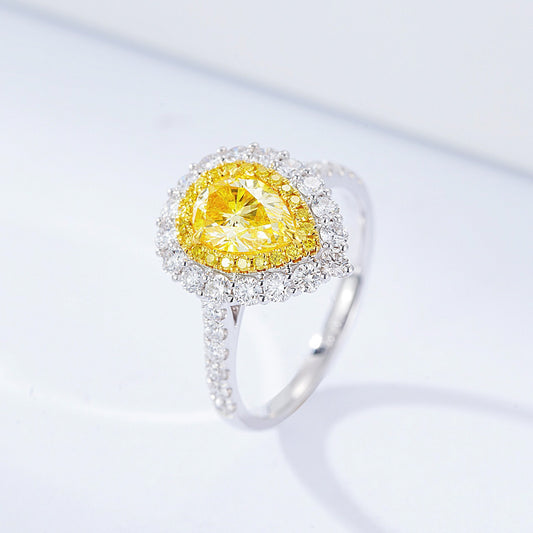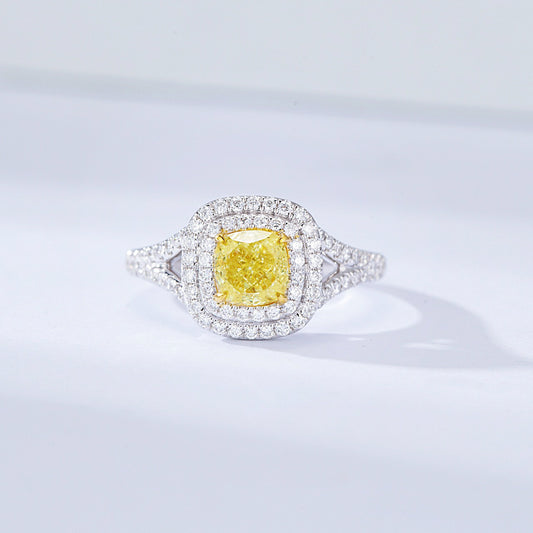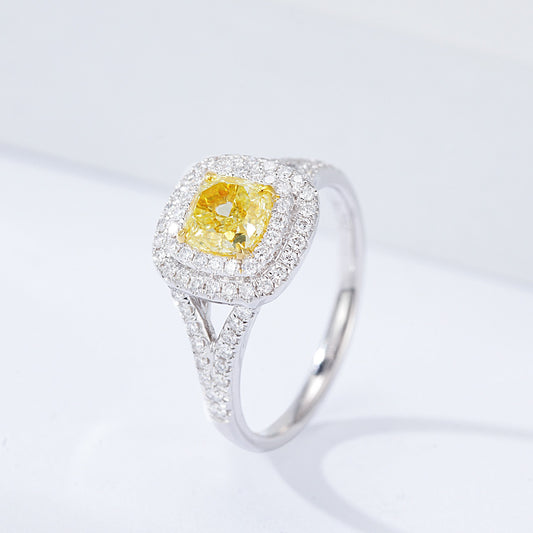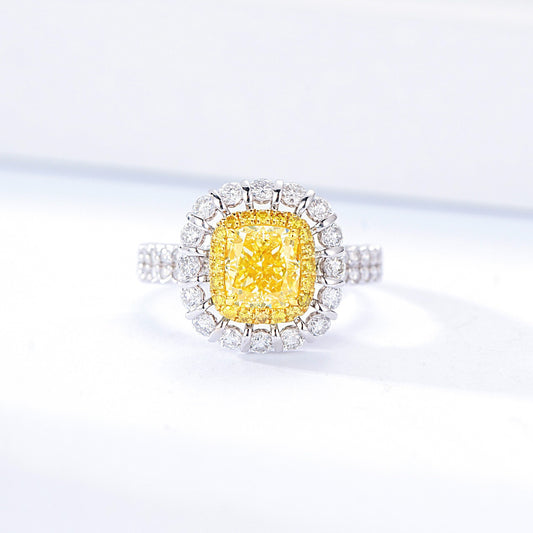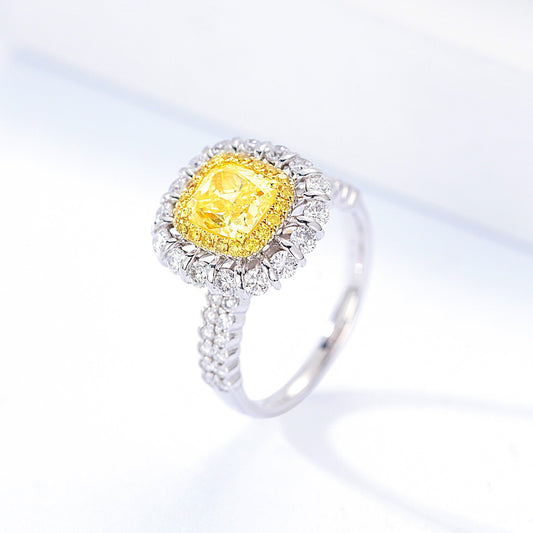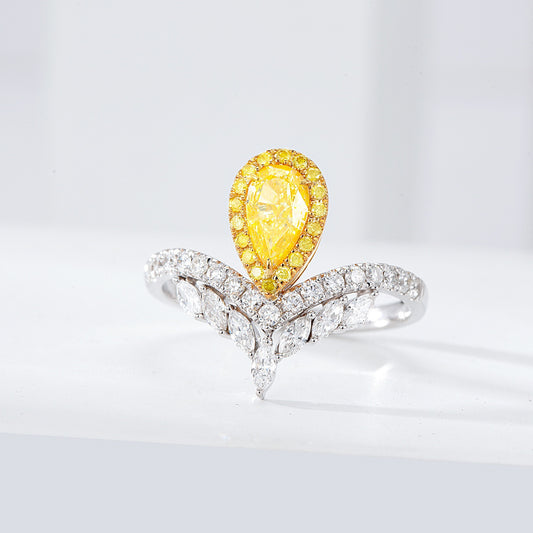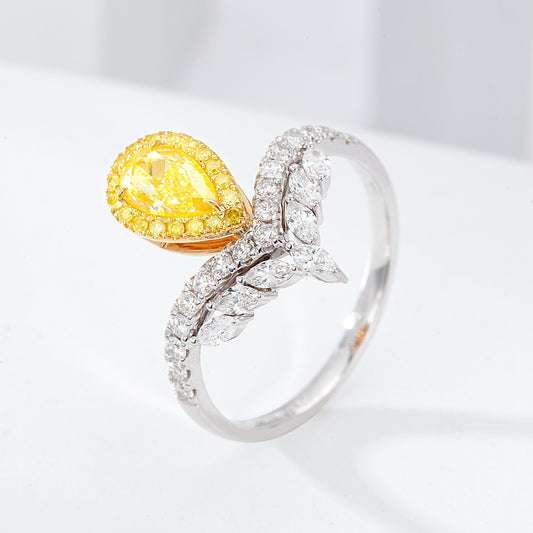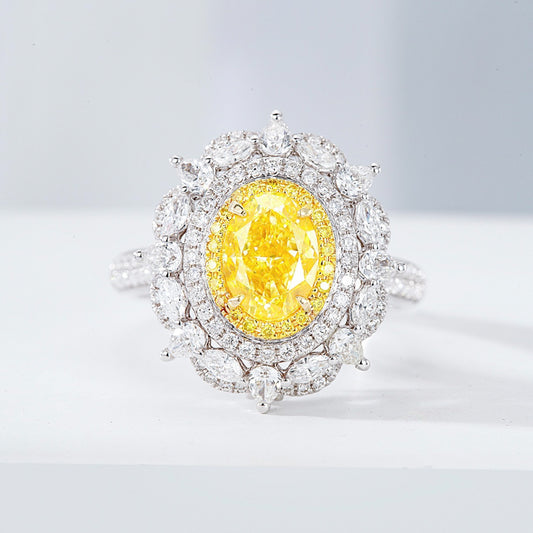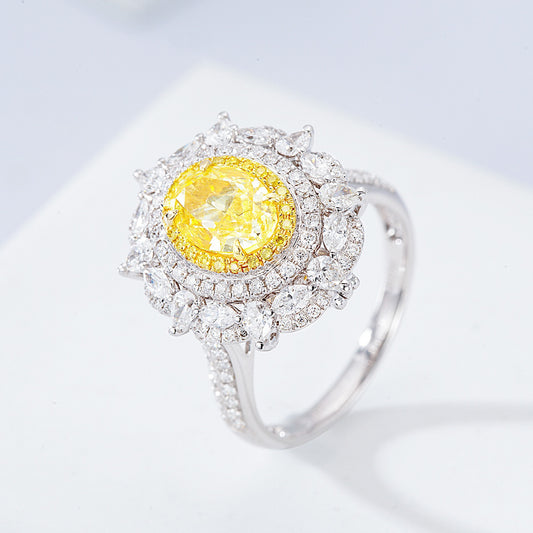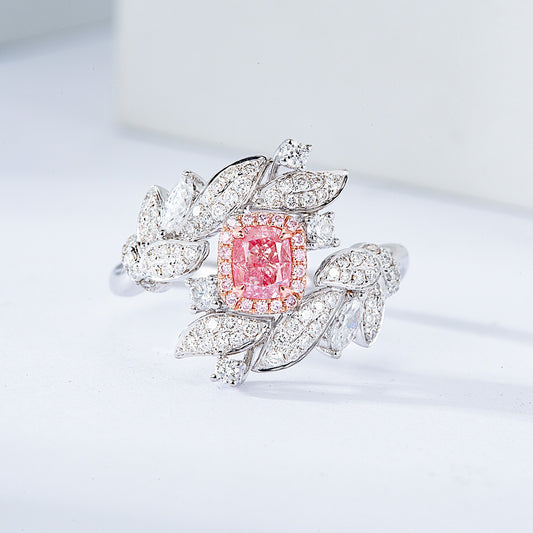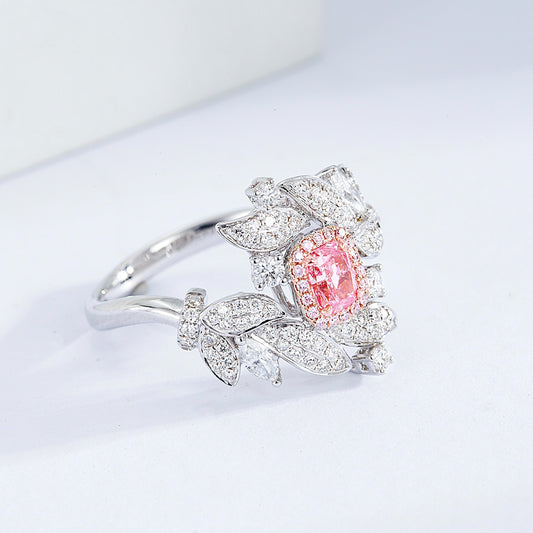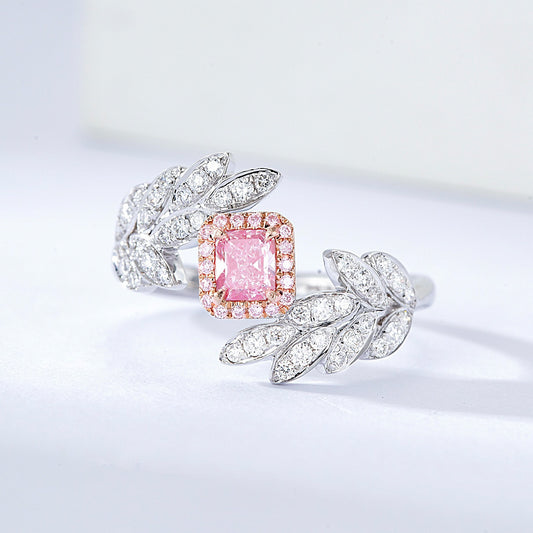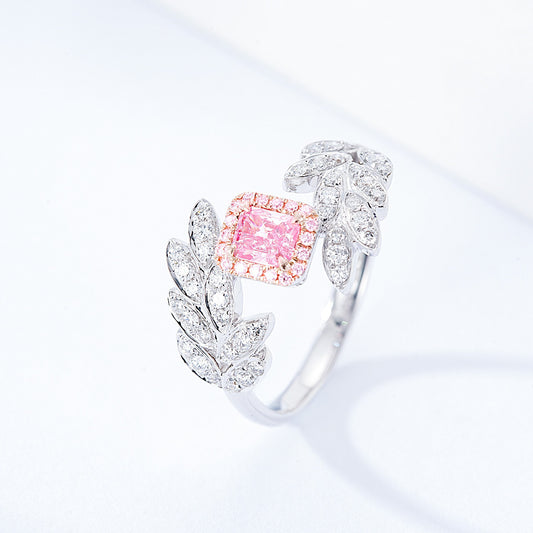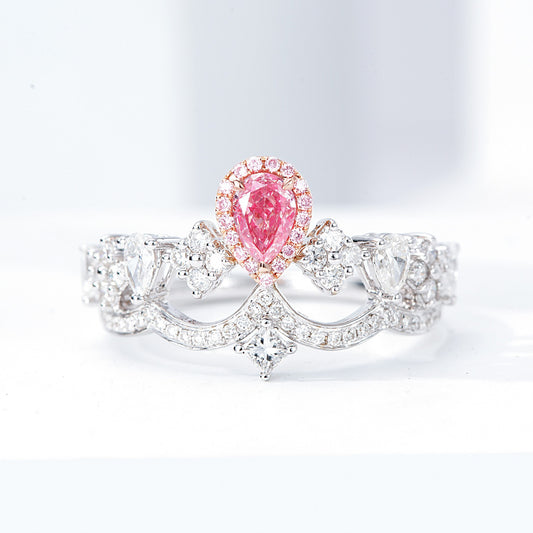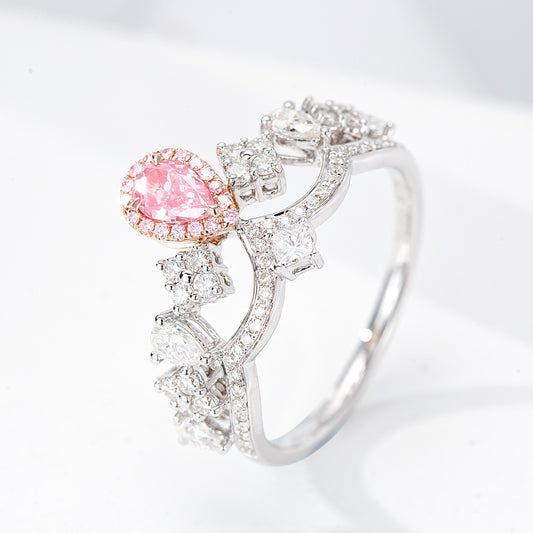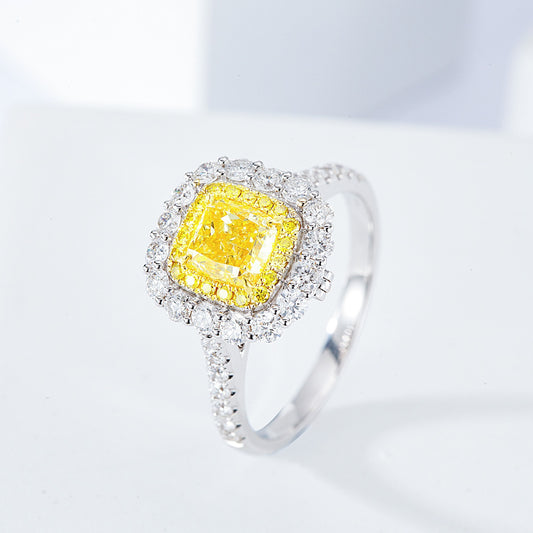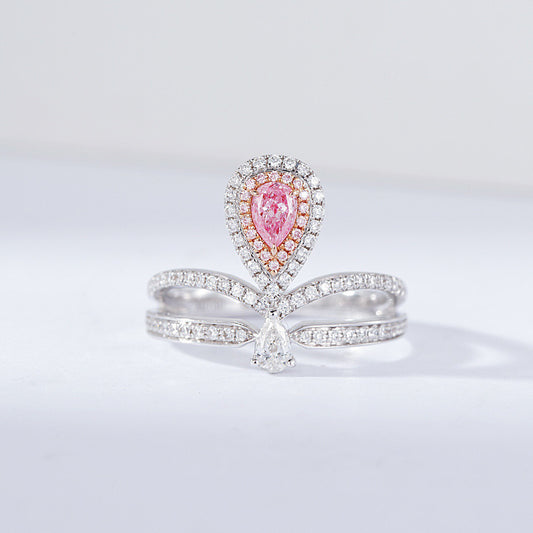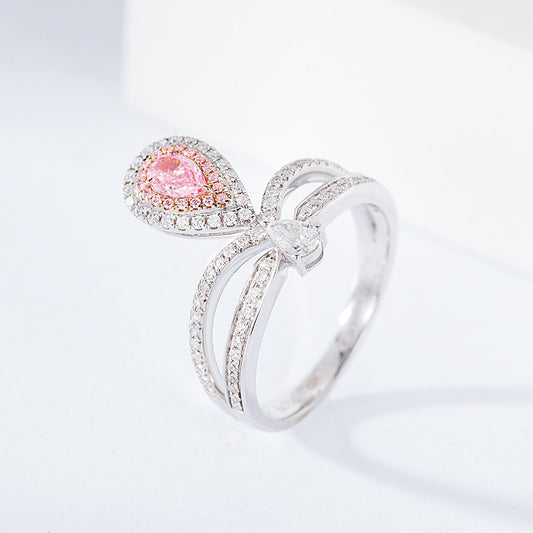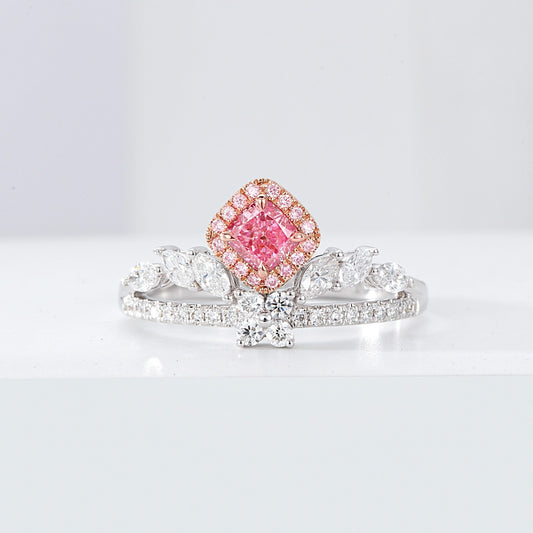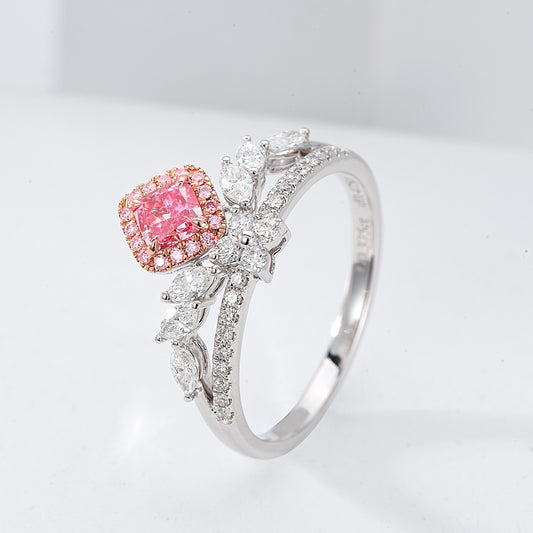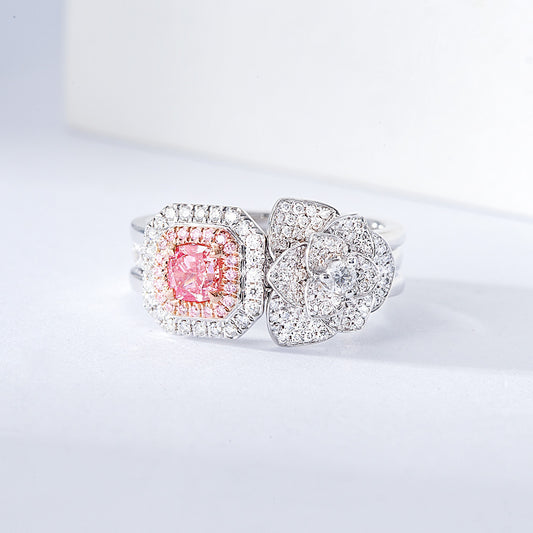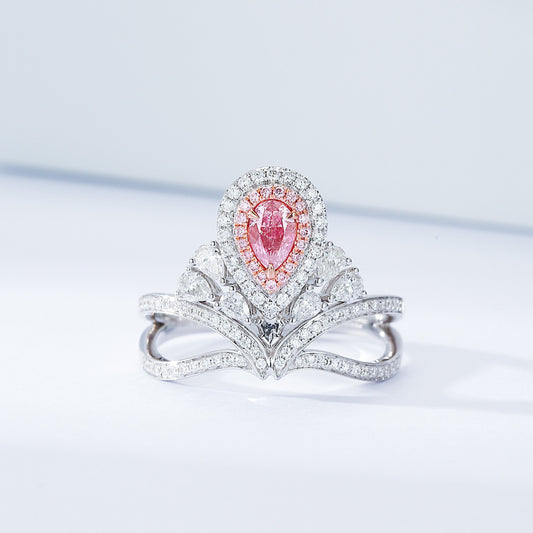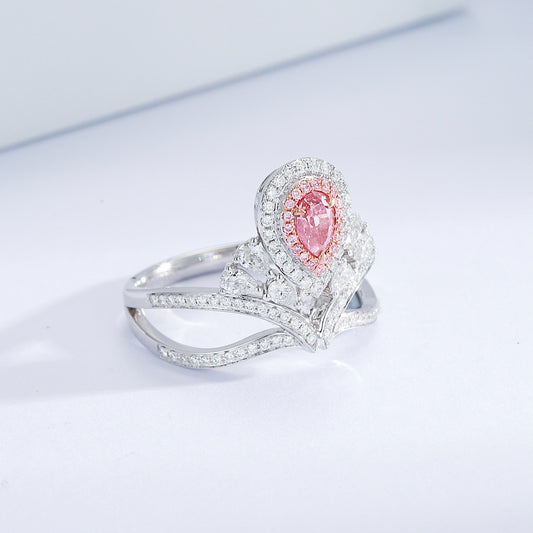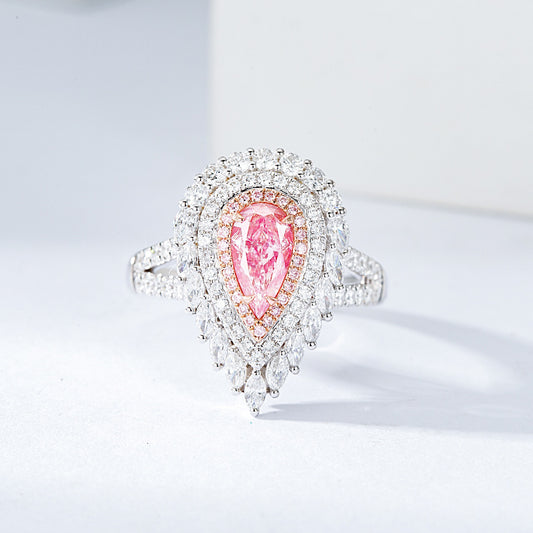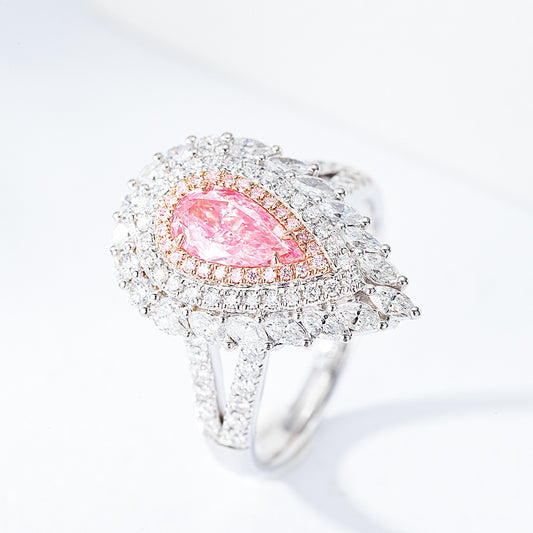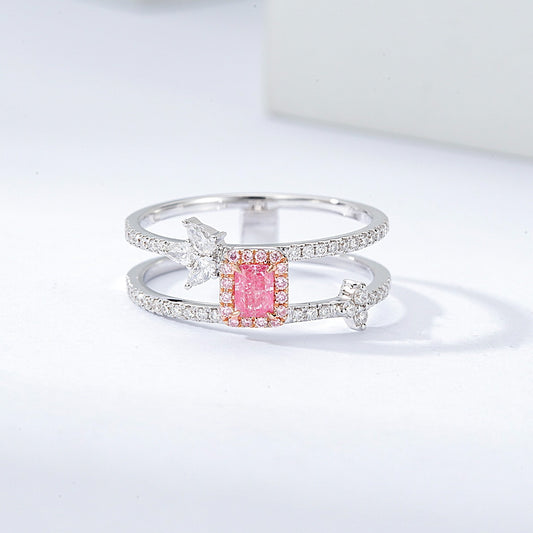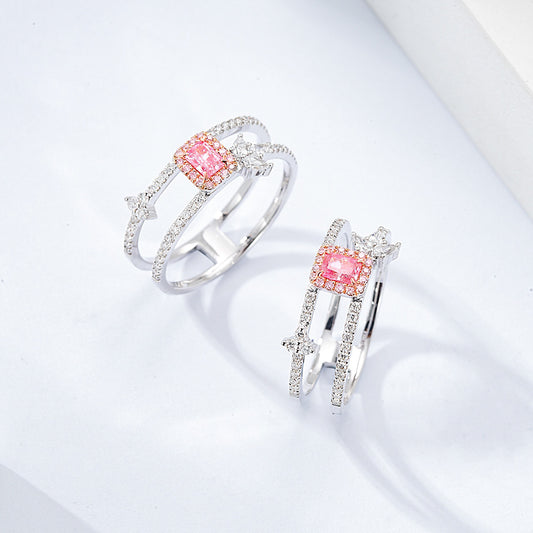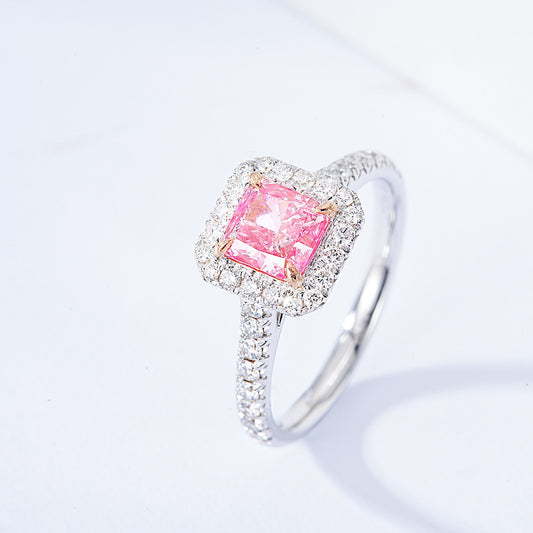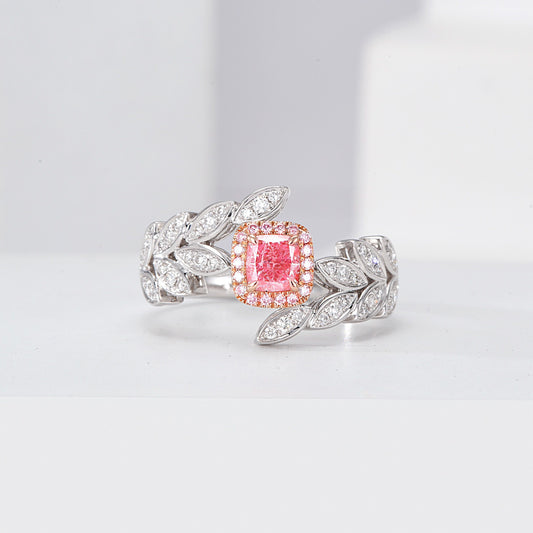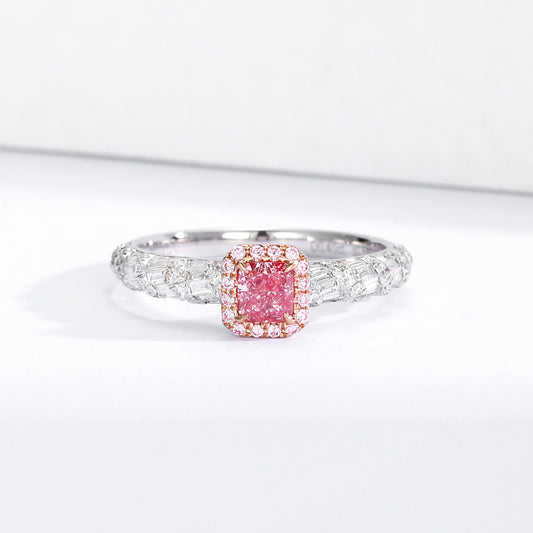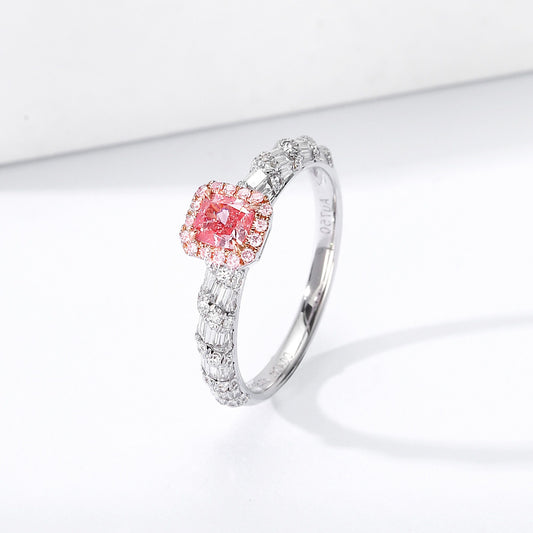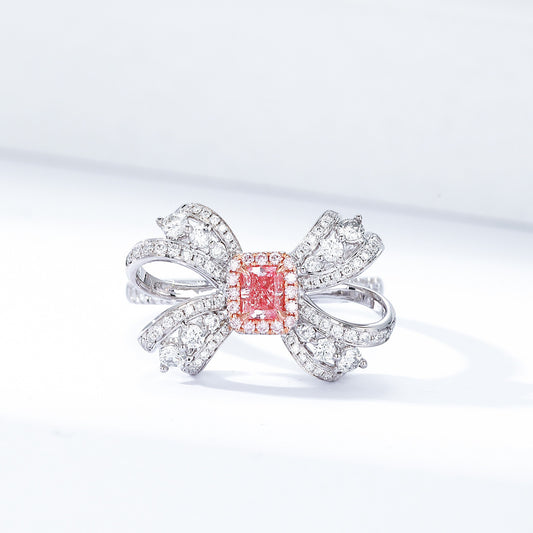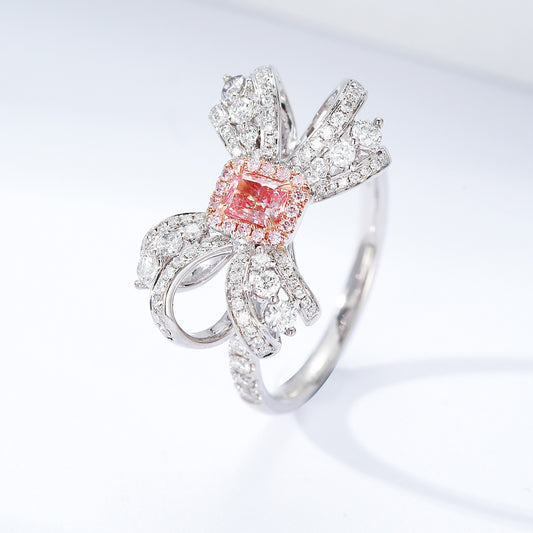-
Heart Shaped Yellow Diamond Ring with Bow Design
The perfect and exquisite, bow-shaped diamond engagement vividly captures what this photograph is about. The ruffled ribbon casing is encrusted with further one point of diamond white and yellow, which contribute additional richness and brightness to the ornament. The ethereal col ornation with rainbow yellow pavé seduces with the imaginary creations, astonishing outlines of the ring. Displayed here is an exquisite Icon pear shape yellow and pavé white diamond engagement ring with a total approximate diamond weight of 2.52 carats.- From $4,970.00
- From $4,970.00
- Unit price
- per
-
Pear Shaped Yellow Diamond Double Halo Engagement Ring with Pavé Band
A pear shape a yellow diamond displaying the most elegant of hues is the centrepiece in our white gold engagement ring. The pear shape yellow diamond center stone is encircled by a gleaming halo of stones, which extends to the gallery beneath and around the band, creating a scintillating silhouette from every angle. A refined diamond and white gold band with a total approximate weight of 1.79 carats.- From $2,450.00
- From $2,450.00
- Unit price
- per
-
Cushion Cut Yellow Diamond Double Halo Engagement Ring with Split Shank
This exclusive engagement ring features a stunning 1-carat cushion-cut yellow diamond as its centrepiece, surrounded by two concentric halos of sparkling white diamonds. The delicate diamond-encrusted split band further enhances the accessibility and elegance of this exquisite design. The ring boasts a total weight of 1.39 carats, with the certified 1.00-carat yellow diamond taking centre stage in a charming, elegant setting.- From $2,790.00
- From $2,790.00
- Unit price
- per
-
Cushion Cut Yellow Diamond Double Halo Engagement Ring with Pavé Accents
A cushion cut yellow diamond displaying the most delicate of hues is the breathtaking centrepiece in our yellow and white gold engagement ring. With its 1.5-carat cushion cushion cut makes an exquisitely statement, encircled by a halo of white diamonds. The combination of the yellow diamond and the surrounding halo makes this engagement ring a timeless symbol of luxury and refined style. An enchanting halo engagement diamond ring with a total weight of approximately 2.52carats.- From $3,570.00
- From $3,570.00
- Unit price
- per
-
Pear-Shaped Yellow Diamond Halo Engagement Ring with V Shaped Diamond Band
The center of this elegant shaped diamond ring is round 0.6 carat yellow diamond and it is ringed with bright yellow diamonds to further make it more attractive. The stylish V shaper band is embellished with 0.57 carat marquises and round cut diamonds making it very pretty. The engagement diamond ring with a total weight of approximately 1.17 carats, showcasing a 0.60 carat pear diamond.- $3,250.00
- $3,250.00
- Unit price
- per
-
Oval Cut Yellow Diamond Double Halo Engagement Ring with Floral Marquise Diamond Accents
A classic diamond cut displaying colour and this entrancing oval yellow diamond is encircled by a glimmering halo of diamonds in our yellow and white gold engagement ring. This accentuates its unique beauty and positioned in a bespoke setting to enhance its uniformly bright and pure colour. The joyful engagement ring with a total weight of approximately 2.67 carats.- From $4,780.00
- From $4,780.00
- Unit price
- per
-
Cushion Cut Pink Diamond Nature Inspired Engagement Ring with Leaf Motif
This nature inspired ring has a center stone that is a-piece cut 0.4 carat pink diamond surrounded by pink diamonds that go perfectly with the pink diamond. The design of the unique band that emulates the soft curves of the leaves has about 0.68 carats of round and marquise diamonds set in. An expressive engagement diamond ring with a total weight of approximately 1.08 carats.- From $4,800.00
- From $4,800.00
- Unit price
- per
-
Cushion Cut Pink Diamond Nature Inspired Engagement Ring with Leaf Design
The center stone of this nature-inspired ring is a 0.3 carat cushion cut pink diamond, which is surrounded by a delicate halo of pink diamonds that contribute to its vibrancy. This open band style features 0.39 carat of round-cut diamonds displaying an elegant leaf pattern resulting in an organic appearance. The contrast between vivid pink centerpiece and intricately arranged round diamonds bestows on this ring sophistication and timelessness; it's meant for anyone who loves both elegance and artistry combined. An enchanting Double Wing Silhouette pave diamond ring with a total weight of approximately 0.69 carat.- From $3,550.00
- From $3,550.00
- Unit price
- per
-
Pear Shaped Pink Diamond Crown Inspired Engagement Ring with Diamond Accents
The core of this captivating ring is a 0.3-carat pear-shaped pink diamond, simply surrounded by a heap of pink diamonds which brings out its vivaciousness. It has an elaborate design with 0.72 carats of white diamond adornments including pear-shaped, round shaped, and princess cut stones which make it look noble and classy. The band that is crescent-shaped appears to be having its own crown imprinted on it to added to the overall glow making it just right for someone looking for unusual statement rings with high-end specs. The unique design is enhanced by 1.02 carats of marquise-cut and round diamonds that gracefully surround each center stone, creating a dynamic and elegant piece.- From $3,990.00
- From $3,990.00
- Unit price
- per
-
Cushion Cut Yellow Diamond Double Halo Engagement Ring with Pavé Band
The exquisitely feminine hue of a 1-carat cushion cut elegant yellow diamond with a cushion-cut tanzanite and a double row of round brilliant diamonds. Radiating pure joy, the bewitching design showcases our expertise in crafting yellow diamond jewels that capture the eye and the heart. The joyful engagement ring with a total weight of approximately 1.85 carats.- From $2,980.00
- From $2,980.00
- Unit price
- per
-
Pear-Shaped Pink Diamond Crown Design Ring with Double Halo
The graceful curves and sparkling diamond accents mean this stylish ring brings out a royal regal look due to its intricate design that perfectly combines a vivid pink center stone with an elegant structure pattern for those who love elegance and dignity in designs. An elegant Pear Shaped Pink Diamond Crown Design Ring with a total weight of approximately 0.65 carat, featuring 0.25 carat pear shape diamonds.- From $4,450.00
- From $4,450.00
- Unit price
- per
-
Cushion Cut Pink Diamond Crown Engagement Ring in 18K White Gold
A diamond of a 0.35 carat is mounted on this engagement ring in a crown design. It features an 18K white gold band adorned with round cut diamonds and pear-shaped side stones whose total weight adds up to approximately 0.47 carat. An enchanting Cushion Cut Pink Diamond Crown ring with a total weight of approximately 0.82 carat.- From $4,180.00
- From $4,180.00
- Unit price
- per
-
Convertible Cushion Cut Pink Diamond and Flower Design Ring Set
This is a stretch in a ring range with a special design that may be put on at once as a pronouncement part or used separately for a simpler style. One ring shows off a pink diamond which is cushion cut and is at the middle pointed out by a double halo of pink and white diamonds. It is evident in its whole look that it carries with itself an aura of grace and elegance about it making one think twice before wanting to take off this magnificent piece from their fingers never mind how tempting they might be. An elegant Convertible Cushion Cut Pink Diamond and Flower Design Ring Set with a total weight of approximately 0.97 carat, featuring 0.40 carat center diamonds.- From $4,970.00
- From $4,970.00
- Unit price
- per
-
Pear Shaped Pink Diamond Ring with Crown Designer 18K White Gold
The graceful curves and sparkling diamond accents mean this stylish ring brings out a royal regal look due to its intricate design that perfectly combines a vivid pink center stone with an elegant structure pattern for those who love elegance and dignity in designs. A charming Pear Cut Pink Diamond Ring with a total weight of 0.89 carat, showcasing a 0.30 carat pear shape diamond and pavé diamond band.- From $4,400.00
- From $4,400.00
- Unit price
- per
-
Pear Shaped Pink Diamond Ring with Double Halo and Marquise Accents
Showcasing an astonishing pear-shaped pink diamond at its centre, this stunning ring is encapsulated beautifully within pink and white diamonds in a dual halo. A number of marquise-shaped stones have been included in the design which add to its intricate layers making it appear luxurious and imperial as well. The vibrant pink gem at the heart of all concerns itself with delicate halo and overlapping diamond ornaments cascade; hence it is the perfect ring for those who want both refinement and daring designs at the same time. An elegant Pear-Shaped Pink Diamond Ring with a total weight of approximately 1.85 carats, featuring 0.70 carat natural diamonds.- From $8,660.00
- From $8,660.00
- Unit price
- per
-
Radiant Cut Pink Diamond Double Band Ring with Arrow Design
At the core of this lovely ring is a 0.15 carat radiant cut pink diamond encircled by a dainty pink halo. It is set with 0.35 carats of round and marquise shaped diamonds on the dual bands arranged as arrows. With its playful yet graceful design showing contrast shapes and colors it is perfect for those individuals who fancy an elegant and stylish statement in jewelry. A charming Radiant Cut Pink Diamond Ring with weight of 0.49 carats.- $2,140.00
- $2,140.00
- Unit price
- per
-
Radiant Cut Pink Diamond Halo Engagement Ring With Pavé Band
Set in this exquisite band is a 1 carat radiant cut pink diamond encircled by a halo of white diamonds that increase its brilliance. The ring's overall sheen and luxury are further enhanced by the band which is pavé-set and has an added 0.48 carats of diamonds. It is a classic and sophisticated design as the pink center stone along with the halo and pavé band thus making it suitable for either engagement or any other event. The Radiant Cut Pink Diamond Halo Engagement Ring with a total weight of approximately 1.48 carats.- From $3,570.00
- From $3,570.00
- Unit price
- per
-
Cushion Cut Pink Diamond Engagement Ring with Olive Branch Design
This delicate ring features a 0.5 carat cushion cut pink diamond which is its focal point while pink diamond halos bring out its vivid hue even more. The open band has 0.25 carat of round diamonds arranged in an intricate olive branch design symbolizing peace; it creates balance between heaviness on top (in the form of the gem) and lightness at bottom (the branches). Because it represents love, life, or other abstract notions such as freedom etc., they are often chosen by women who want something different from what everyone wears. An enchanting live branch design marquise and cushion cut pink diamond ring with a total approximate weight of 0.75 carat.- From $4,390.00
- From $4,390.00
- Unit price
- per
-
Cushion Cut Pink Diamond Engagement Ring with Baguette and Round Diamond Accents
The centerpiece is composed of a cushion-shaped pink diamond weighing 0.40 carats while its vibrant color is complemented by finely set pink diamonds that surround it. And to make sure that the design has some depth as well as sophistication, the band is embraced with a mix of emerald-cut and round diamonds having an approximate weight of about 0.59 carats in totality. The versatile pink center stone blended with rectangular emeralds and circular diamonds creates a sumptuous item that thrives in any social gathering. The elegant Cushion Cut Pink Diamond ring with round diamond band with a total weight of approximately 0.99 carat.- From $4,090.00
- From $4,090.00
- Unit price
- per
-
Radiant Cut Pink Diamond Ring with Bow Design in 18K Gold
This beautiful ring has a 0.25 carat cushion cut pink diamond in the center of it which is surrounded by a thin halo that makes the color even more vivid. On top of that, there are some 0.62 carats worth of glittering diamonds set on the bow inspired part giving this piece an overall sense of sophistication and grace. The curling details and line of this design manage to mix together playfulness as well as refinement making it suitable for people who like old-fashioned allure along with new century art work. Radiant Cut Pink Diamond Ring with bowknot design in 18K gold with a total weight of 1.40 carats, showcasing a certified 0.25 carat round diamond with natural diamond.- From $3,350.00
- From $3,350.00
- Unit price
- per
Engagement Rings
Engagement rings are timeless symbols of love and commitment, traditionally given as apromise of marriage. Each ring carries deep personal meaning, reflecting the unique bond between two people. From classic solitaires to intricate designs with multiple diamonds, engagement rings come in a variety ofstyles to suit every taste and preference. The choice of metal, setting, and stone shape allows couples to create aring that perfectly captures their love story.
Today’s engagement rings blend tradition with modern trends, offering endlesspossibilities for personalization. Whether it’s a vintage-inspired design with intricate detailing or a sleek,minimalist style, the ring serves as a lasting reminder of the special moment when two lives come together. Withoptions ranging from sparkling diamonds to colored diamonds, and from simple bands to elaborate settings,engagement rings continue to evolve, allowing each couple to find a ring that’s as unique as their relationship.
Explore Related Pages
FAQs about Engagement Rings
Engagement ring settings refer to how the diamond or gemstone is mounted on the ring. It focuses on the structural aspect of the ring, such as whether the stone is held by prongs, set in a bezel, or surrounded by a halo of smaller stones. Examples of settings include prong, bezel, and tension settings.
Engagement ring styles, on the other hand, refer to the overall design and aesthetic of the ring. This includes the combination of the setting, the band, and other design elements that create a particular look or theme, such as a solitaire, vintage, or modern style.
In summary, the setting is a component of the ring's style, contributing to the overall design but specifically referring to how the stone is held in place.
Engagement ring styles vary widely, offering a range of designs to suit different tastes and preferences. Some of the most popular styles include:
- Solitaire: A classic and timeless choice, the solitaire features a single diamond or gemstone, allowing the stone to be the focal point. It's known for its simplicity and elegance.
- Halo Engagement Rings: This style surrounds the center diamond with a halo of smaller diamonds, enhancing the overall sparkle and making the center stone appear larger.
- Three Stone Engagement Ring: Symbolizing the past, present, and future, this style features three diamonds or gemstones set in a row, often with the center stone being the largest.
- Pavé Engagement Ring: In this style, the band is encrusted with small diamonds set closely together, creating a continuous sparkling surface that enhances the overall brilliance of the ring.
- Vintage Engagement Rings: Vintage-inspired rings draw from various historical design elements, often featuring intricate details, milgrain edges, and unique settings that evoke the charm of a bygone era.
- Nature Inspired Engagement Rings: These rings incorporate natural elements like leaves, vines, or floral motifs, creating a design that reflects the beauty of the natural world.
- Luxe engagement rings: Luxe engagement rings are designed for those who appreciate opulence and sophistication. These rings often feature larger diamonds or gemstones, intricate designs, and high-quality materials, creating a look of luxury and grandeur that stands out.
- Split Shank Engagement Rings: The band of the ring splits into two or more strands as it approaches the center stone, adding a unique and stylish twist to the classic engagement ring design.
These styles offer a range of options, allowing couples to choose a ring that best represents their personal style and the sentiment behind their commitment.
The number of prongs on an engagement ring typically varies depending on the style and size of the diamond or gemstone, as well as personal preference. The most common options are:
- Prongs: This is a popular choice for many engagement rings. Four prongs offer a balance between security and allowing maximum light to enter the diamond, enhancing its brilliance. This setting is often used for round, princess, and cushion-cut diamonds.
- Six Prongs: Six prongs provide extra security for the diamond, making it less likely to be dislodged or damaged. This setting is particularly common for larger diamonds or those in solitaire rings, where the stone is the main focus.
- Other Options: Some rings may have more than six prongs for added security, especially for larger or more valuable stones. Alternatively, some designs might use three prongs or fewer for a more delicate or modern look.
Ultimately, the number of prongs should provide a good balance between securing the stone and enhancing its appearance.
The cost of an engagement ring can vary widely based on several factors, including personal preferences, the quality of the materials used, and individual budget constraints. Here are some general guidelines to consider:
- Budgeting: Traditionally, it's often suggested to spend about two to three months' salary on an engagement ring. However, this guideline is flexible and should be adjusted based on personal financial circumstances.
- Quality: The price of an engagement ring is significantly influenced by the quality of the diamond (or other gemstones) and the precious metal used for the setting. Diamonds are graded based on the Four Cs (Cut, Color, Clarity, and Carat Weight), with higher grades commanding higher prices.
- Setting and Design: Elaborate settings, custom designs, and additional features like pave diamonds or intricate detailing can increase the cost of the ring.
- Market and Location: Prices can vary depending on where you purchase the ring (local jeweler vs. online retailer, for example) and market conditions.
- Personal Priorities: Ultimately, what matters most is finding a ring that fits within your financial comfort zone and that holds personal significance for both you and your partner.
To determine a specific budget, consider discussing expectations with your partner, exploring various options within your price range, and seeking advice from a reputable jeweler. The goal is to find a ring that symbolizes your commitment and fits comfortably within your financial means.
Wearing an engagement ring carries several symbolic meanings, which may vary across cultures and personal beliefs. Here are some common meanings associated with wearing an engagement ring:
- Commitment and Promise: The engagement ring is a symbol of commitment and promise between two people who plan to marry. It represents a formal agreement to enter into a lifelong partnership.
- Love and Devotion: It signifies the love and devotion that one partner has for the other. The ring serves as a visible and tangible reminder of the deep emotional connection and affection shared between the couple.
- Future Together: Wearing an engagement ring often symbolizes a shared vision of a future life together, including dreams of building a family, creating a home, and supporting each other through life's challenges.
- Status and Announcement: In many cultures, wearing an engagement ring announces to the world that a person is in a committed relationship and is preparing to marry. It can symbolize a transition in social status from being single to being engaged.
- Tradition and Ritual: Engagement rings are deeply rooted in cultural traditions and rituals surrounding marriage. They often carry familial and societal significance, marking a significant milestone in the couple's journey towards marriage.
Overall, the meaning of wearing an engagement ring is deeply personal and can vary based on individual beliefs, cultural practices, and the significance attached to the ring by the couple and their community.
The tradition of both partners receiving engagement rings is not as common as the tradition of only one partner receiving an engagement ring, typically the person proposing marriage. Here are a few scenarios where both partners might receive engagement rings:
- Mutual Proposal: In some cases, couples may mutually decide to propose to each other simultaneously or in close succession. In such situations, both partners might exchange engagement rings as a symbol of their commitment and intention to marry.
- Equality and Symbolism: Some couples choose to exchange engagement rings as a symbol of equality and mutual commitment in their relationship. This can be a modern interpretation where both partners want to express their love and dedication with a ring.
- Personal Preference: It ultimately comes down to personal preference and the dynamics of the relationship. If both partners value the symbolism of wearing an engagement ring and wish to exchange rings, they are free to do so according to their own traditions or beliefs.
In most traditional practices, however, only one partner typically receives an engagement ring as part of the proposal ritual. This ring symbolizes the commitment and promise of marriage, while wedding bands are usually exchanged by both partners during the wedding ceremony itself.
- Choosing a selection results in a full page refresh.
